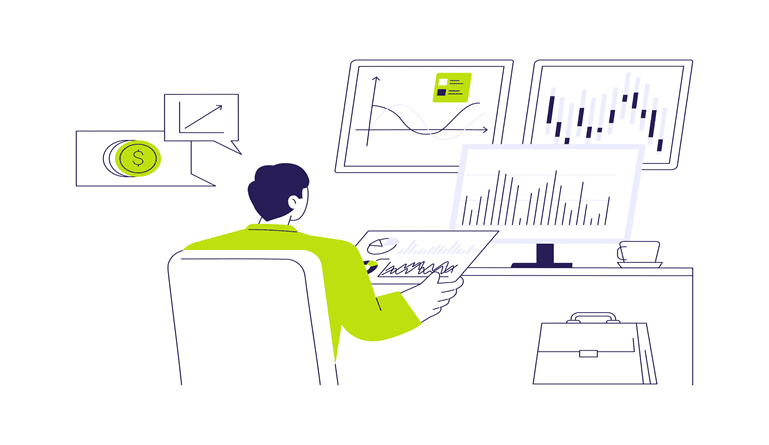How financial professionals can use big data analytics in the finance industry.
Best ways to enhance the finance industry with the help of big data analytics.
Big data
Data Analytics
Data Visualization
These are three terms that you hear every day, in every conversation about digital transformation and company growth.
In today’s data driven business environment, Data analytics and data insights are used in almost every decision making process, whether the decision is a small one or one that involves the company’s future. This holds true for the finance industry in particular.
“The most interesting trend will be whether banks and financial services providers succeed in their mission to leverage Big Data while adhering to compliance requirements and security standards” says Sheila Lindner, President of Octacom.
Many companies in the finance industry are already taking steps to make the most of the data they hold and improve their services.
- In October 2016, Lloyds Banking Group became the first European bank to implement Pindrop’s Phone printing technology to detect fraud.
- Danske Bank uses advanced analytics to evaluate customer behaviour and determine preferences, and to identify fraudulent actions, thus reducing false positives.
- JPMorgan Chase developed a proprietary machine learning algorithm, called Contract Intelligence or COiN, for analyzing various documents and extracting important information from them.
Thus, it is evident that the application of big data in the finance industry will open multiple avenues for improvements in the financial services. Here are some aspects where big data analytics can definitely add value to:
#1. Enhancing Financial Models
Financial institutions such as banks, lending institutions and trading concerns generate a lot of data every day. In order to effectively manage such huge chunks of data, they need to rely on data handling programs and applications. These institutions usually have many different business models, taking into account the various services they offer. All the data and data trends need to be taken into consideration to create efficient working models and actionable strategies.
#2. Better Data Processing and Storage
Over the years, financial institutions have gathered a lot of data. With rapid digitization and increasing use of data in almost all facets of decision making, this database that companies have created is only bound to increase exponentially. Therefore, big data uses codes and algorithms to continuously process large volumes of data, and to manage the data clouds or shared servers.
#3. Machine Learning Generates Better Returns
Banks and financial service providers interact with customer data on a daily basis. This information is not only extremely critical for providing a customer experience, but is also very valuable in terms of the insights that can be derived from it. Most such institutions have now started incorporating artificial intelligence and machine learning codes to facilitate services and enhance fraud detection measures. This is another field where big data is very beneficial.
#4. Credit Scoring
One major task bestowed upon lending institutions is to be able to calculate an effective credit score, factoring in as much data as possible. Credit scoring is a highly sensitive activity that can affect the overall corporate image and business credibility. Therefore, such institutions make use of a combination of business intelligence software and big data analytics to accurately calculate the credit score.
#5. Blockchain Technology
Blockchain technology is on the rise, particularly given the cyber security threats and GDPR and data compliance measures. This has a huge application for big data, as in a blockchain network, data is stored in ledgers, which are distributed and saved on the servers of participating bank. Since the information is distributed among various banks and banking platforms, the system is nearly impregnable against hacking. The larger the network, the more secure the blockchain. This way, it can secure the transactions and offer an extra layer of security to the organizations dealing with sensitive data.
#6. Customer Segmentation
Banks are now making the shift from being a business-centric to customer-centric models. In order to facilitate this shift, banks need to perform customer segmentation to be able to provide better financial solutions to their customers. Big data aids the banks in this process, by segmenting customers on the basis of both historic and real-time data, thus both easing and hastening the process.
#7. Customer Acquisition
As discussed above, big data takes into account historic and real-time data to segment customers. Once the segmentation is complete, you can profile the kind of customers most likely to be in need of or avail your services. After this, you simply need to create your marketing strategies ai med towards them.
#8. Marketing, Customer Retention, & Loyalty Programs
After segmenting and profiling the target markets using big data, companies can easily run their marketing campaigns, both offline and across social networking platforms. Not only will this generate more leads and conversions, but will also create a huge customer base and help in creating effective customer retention and loyalty programs that benefit both customers and the banking institutions.
The financial industry is slowly transforming with the fintech industry. The catalyst in this movement is Big Data Analytics. More and more institutions are now relying upon big data analytics and data visualization to may carry out effective visual representation of their vital data for expansion and growth.




